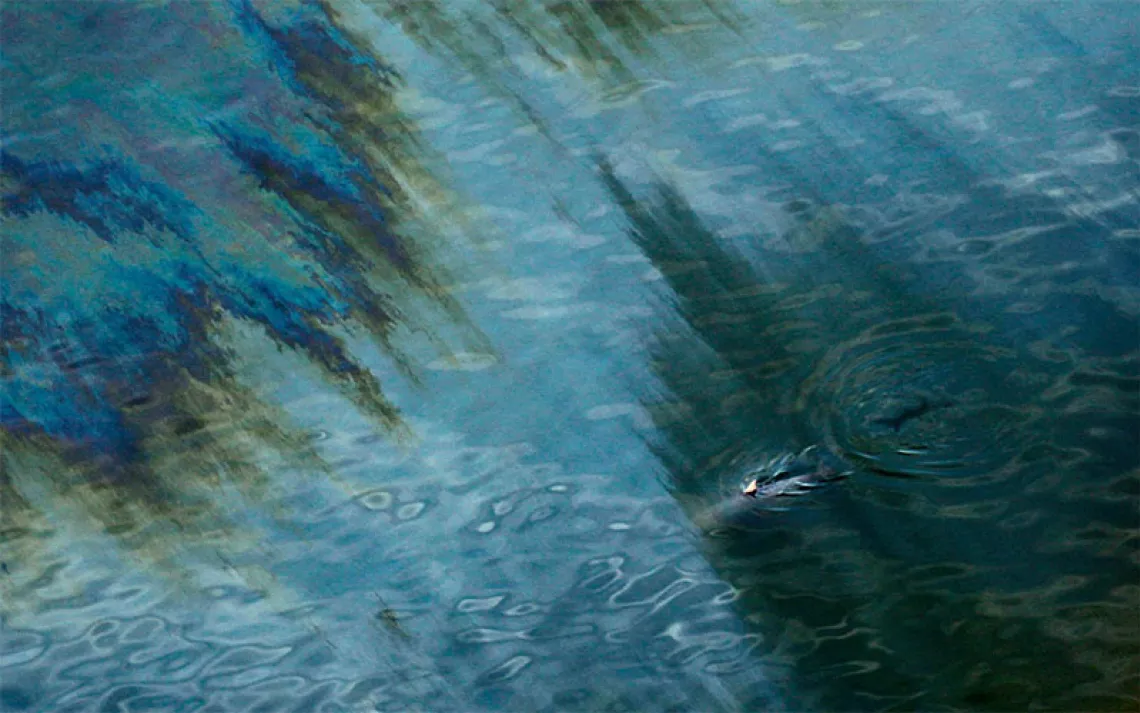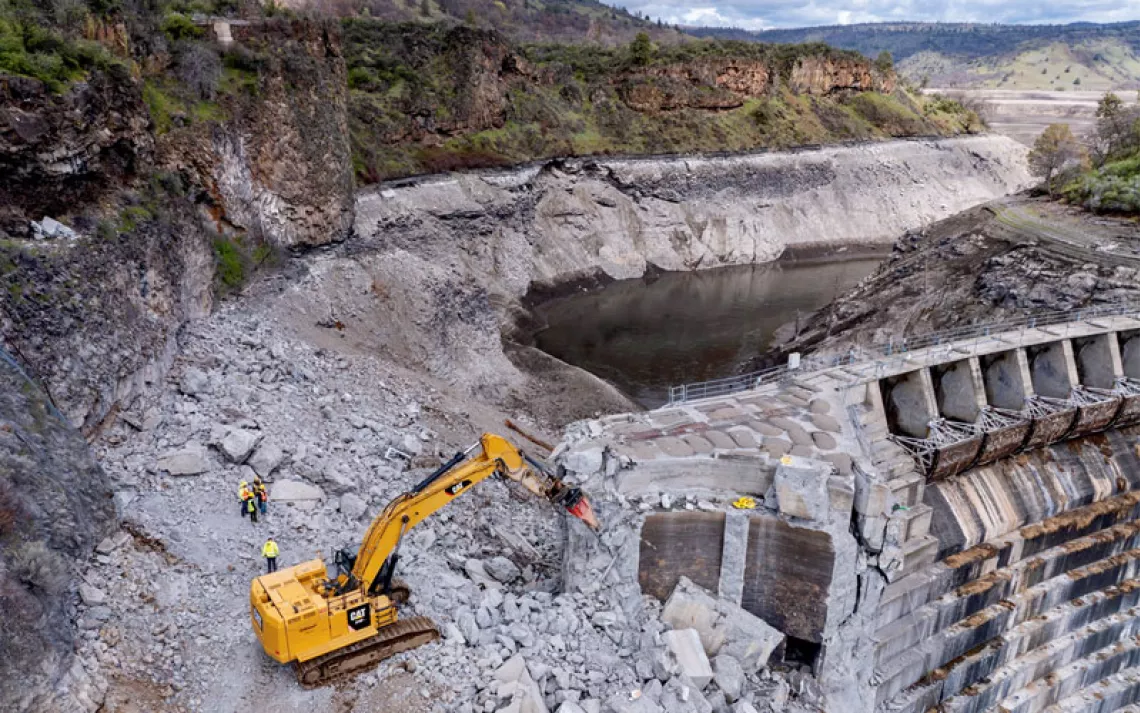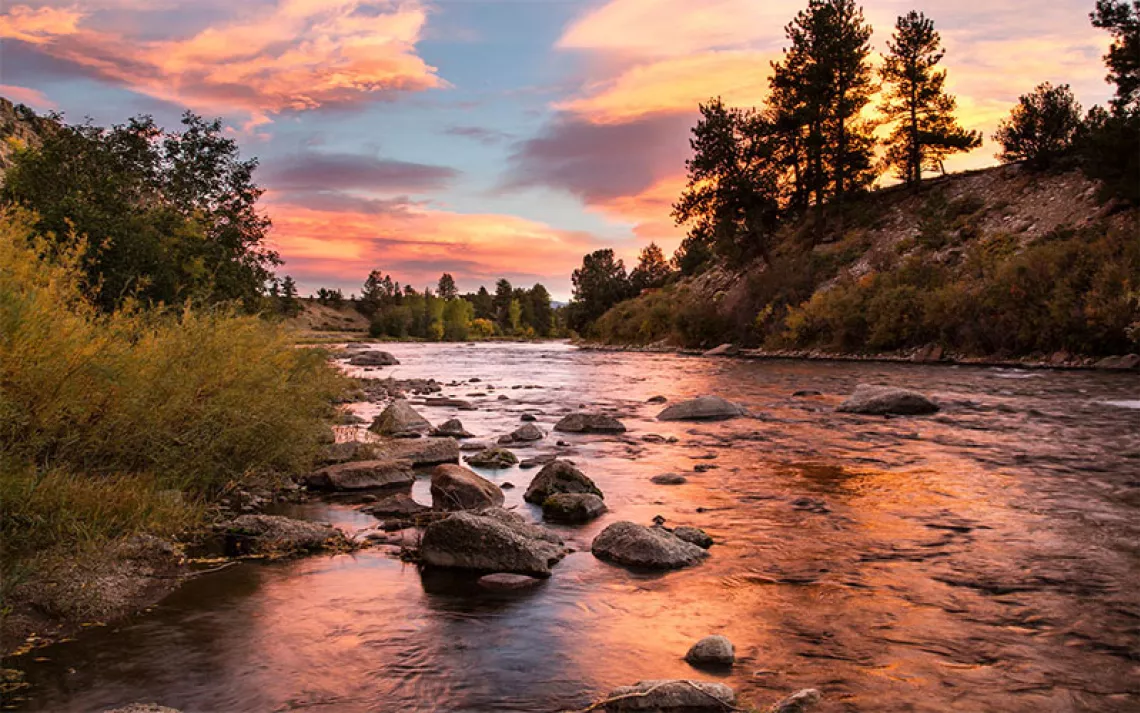Oasis in the Desert
Against long odds, the Colorado River Delta in Mexico is being restored
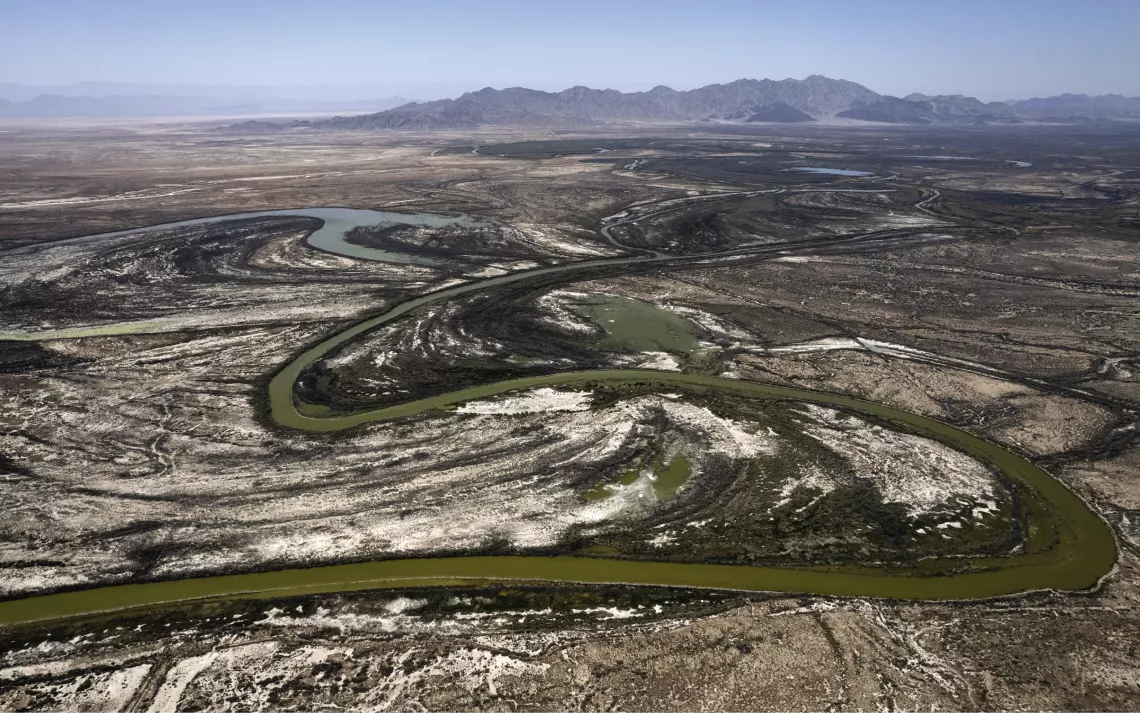
The Colorado River wends its way through the Mexicali Valley.
SOUTH FROM THE CALIFORNIA–Baja California border on Mexico's Highway 5, past the smog-laden city of Mexicali, the Mexicali Valley is barren and desiccated. The distant mountains of the Sierra Cucapah blur into a haze. Then everything changes. Just past the dusty farming town of Ejido Durango, a dense forest emerges alongside an irrigation canal. An unmarked road leads into the green depths, ending at a lagoon.
This is Laguna Grande, an 800-acre preserve less than a mile from the main stem of the Colorado River, where a remarkable transformation has occurred. What was once an inhospitable plain is humming with insects and birds. Bobcats slink through trees, and beavers scavenge for the wood they use to build the dams that have popped up in the lagoon's winding channels.
On a warm day in late April, I accompanied Gabriela González and Carlos Restrepo into a thicket of cottonwood trees standing improbably amid the croplands and desert of the valley. González was working as the environmental education coordinator at the Sonoran Institute, and Restrepo was, at the time, one of its biologists. For more than a decade, the binational environmental institute has worked with five other nongovernmental groups to restore Mexico's Colorado River Delta as part of the coalition Raise the River.
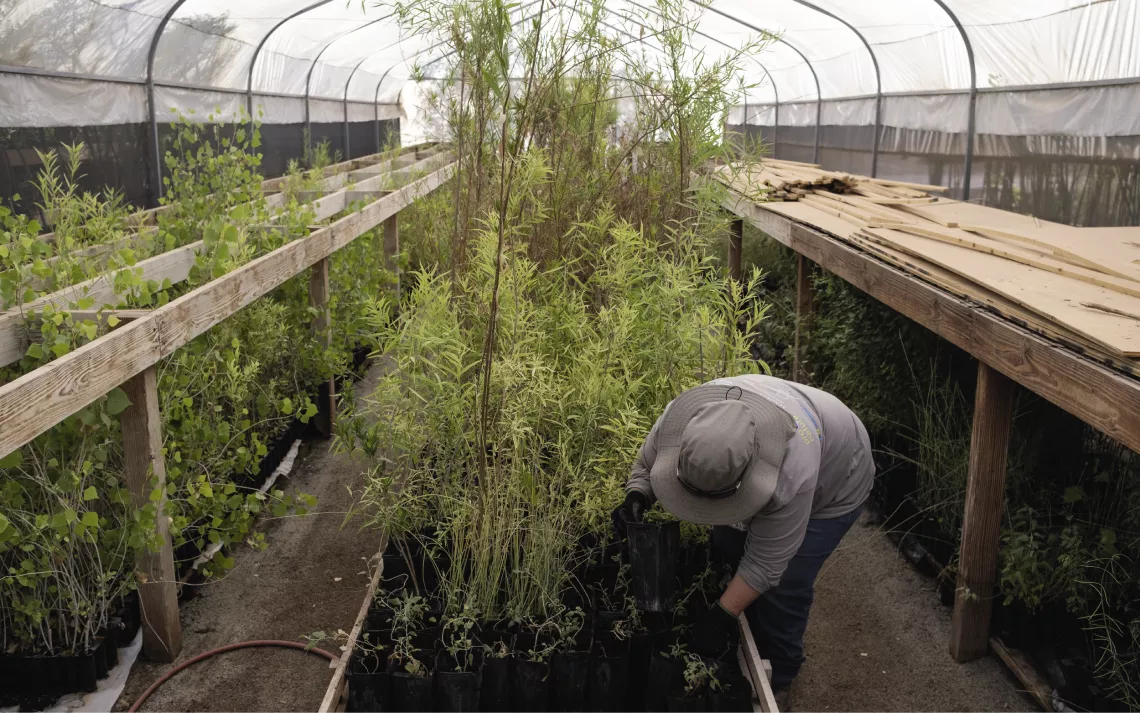
The Sonoran Institute's tree nursery.
González bent over to pick up a handful of fluffy cottonwood seeds that looked like patches of snow scattered across the forest floor. "They float in the water, which allows seeds to spread," she explained, noting how spring runoff from the Colorado River helps disperse the cottonwood seeds throughout the riparian corridor.
"It's all coupled," added Restrepo. For millennia, the delta was one of North America's largest wetlands. Double the size of Louisiana's Atchafalaya Basin, it was a landscape of 1.9 million watery acres created by the braided channels of the Colorado River draining into the sea at the end of a 1,440-mile journey from high in the Rocky Mountains. Well into the mid-20th century, the delta was so full of lagoons and marshes that locals traveled by boat between villages.
As the population of the American Southwest and the Mexicali Valley grew, the United States and Mexico signed a treaty in 1944 to govern the distribution of water from the Colorado River. Most of the water was divvied up for agriculture and cities. Crucially, the two nations allotted no water for the river itself and its basic functioning. In a matter of decades, much of the delta's emerald lagoons and riparian forests morphed into a virtually treeless desert—the result of continuing population growth and agricultural development on both sides of the border. By the 1970s, water no longer flowed through the delta, save for a few stubborn trickles, and the landscape began to die.
Today, Laguna Grande is the largest and thickest stand of riparian habitat along the Colorado River in Mexico. Other pockets of the delta have begun to reemerge as well, the product of an unprecedented binational restoration effort involving nonprofit groups, the US and Mexican governments, and Mexicali Valley communities. A historic 2012 agreement between the United States and Mexico reallocated water to the delta for environmental purposes. The agreement facilitated the inaugural "pulse flow" of 2014, which rushed through the head gates of the Morelos Dam and into the delta, allowing the Colorado River to reach the sea for the first time in decades. Since then, the two countries have continued small but consistent "base flow" water releases to maintain groundwater levels at restoration sites throughout the delta.
In this hot and polluted place, González has made it her mission to connect people with that story of revival and with a natural landscape that many thought they had lost—and that some never knew they had. For her, the delta is not merely an emblem of environmental crisis but a sign that even the most degraded places are not beyond saving.
AT THE EDGE OF LAGUNA GRANDE'S marshy lagoon, a lone cottonwood towers above the other trees—a rare survivor that made it through the decades of no water. Without the pulse flow, it's unclear how much longer such big trees could have survived. "They were on the brink of extinction," González said. "If 40 years [of no water] eliminated almost 90 percent of the species, then 15 more years . . ." She didn't need to finish the sentence.
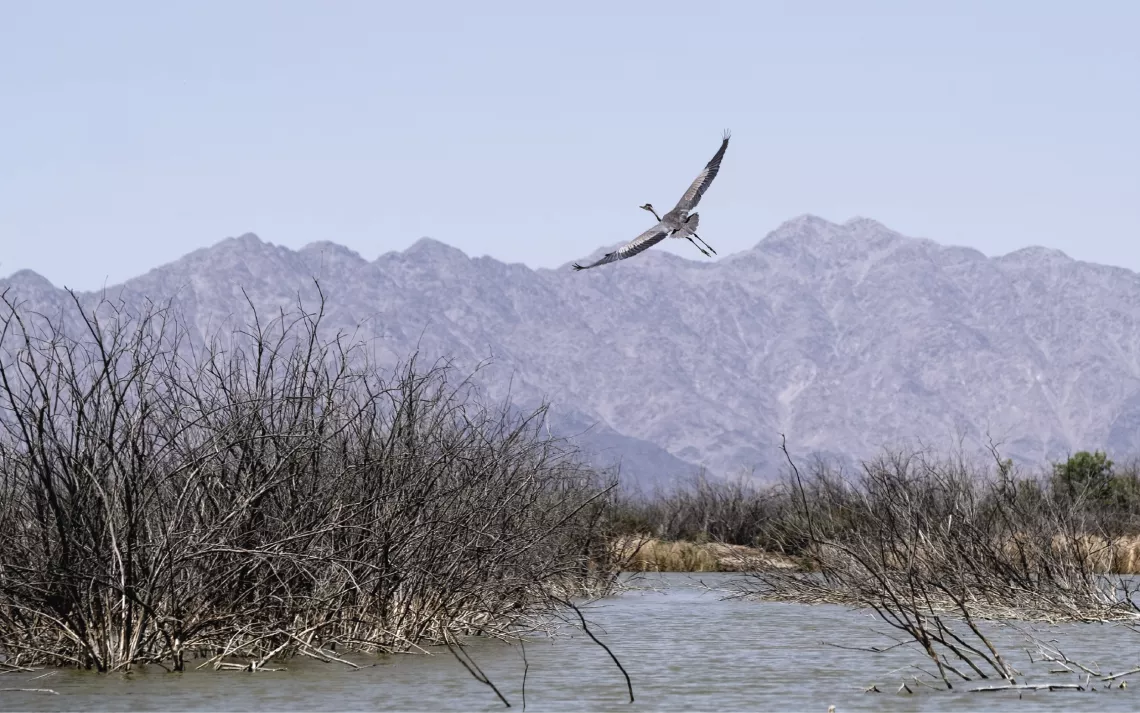
A stork flies above the delta estuary.
The story of the delta's revival began in the early 1990s, when two Mexican graduate students in ornithology, Osvel Hinojosa and Francisco Zamora, first visited the delta and realized its crucial location along the Pacific Flyway, the main route for birds migrating between South America and North America. The once lush riparian landscape would have been an ideal place for birds to rest and refuel before their grueling journey across the Sonoran Desert. Spurred by the researchers' findings about the region's bird populations, the Mexican government declared the delta a priority conservation area in 1992, and the two ornithologists began envisioning how to bring the ecosystem back to life.
No one had restored a riparian habitat in a landscape as dry and hot as the Mexicali Valley. But a series of flooding events in the late 1980s and again in the '90s had created small spurts of growth along the Colorado River's riparian corridor and even reconnected the river with the sea for the first time in years, buoying Hinojosa and Zamora's hope that restoration was possible.
In 2002, they joined 55 scientists, water managers, and local resource users from the United States and Mexico to sketch out priorities for future conservation in the Colorado River Delta and Upper Gulf of California. They identified 15 conservation priority areas that, with proper management, would ensure the long-term survival of the delta's biodiversity. In 2004, Hinojosa and Zamora and several collaborators published a report laying out their restoration vision. The authors described it as "a map of the possible."
The report identified a "lack of freshwater inputs" as a principal threat to the delta and Upper Gulf of California ecosystems. The 2012 treaty renegotiation, which came after five years of talks, finally returned more water to the Mexican side of the river. The new agreement gave 158,088 acre-feet over a five-year period to the delta to rejuvenate native flora and fauna. That volume was just 1 percent of the river's historic flow. But in the form of a large pulse flow and smaller base flow releases over the next four years, it would be enough to sustain the restoration sites.
Hinojosa and Zamora were inspired by "rewilding"—the idea that we can rebuild damaged ecosystems. Those efforts started at Laguna Grande in 2008, when the Sonoran Institute began replanting native trees in long, neat rows, irrigating them with water purchased from nearby farmers. Not knowing how many trees would survive, they packed them together as densely as possible. The trees flourished; their survival rate was more than 90 percent, and the resulting forest was so thick that it was hard to walk through. It was a learning experience, González said. In subsequent restoration efforts, they created more space between the trees and brought in more species diversity to better align with the site-specific conditions: willows for areas with shallow groundwater, mesquite for drier areas with deeper groundwater.
The 2014 pulse flow traveled down the main stem of the Colorado River and into the delta—a tongue of water creeping across the dry land, wetting an ecosystem that in some parts had not felt water in decades. It was the primer that sites like Laguna Grande needed for the restoration efforts to take off. With the flood of water, long-dormant vegetation blossomed along the riparian corridor. Egrets and ospreys were spotted flying above the water's path. Eventually, the water reached the Gulf of California. After the water stopped flowing, the greenery and species that had surged in the wake of the pulse flow began to dwindle, but the smaller, subsequent releases eventually took effect, revitalizing bird and animal habitat and allowing the Sonoran Institute's planting efforts to flourish.
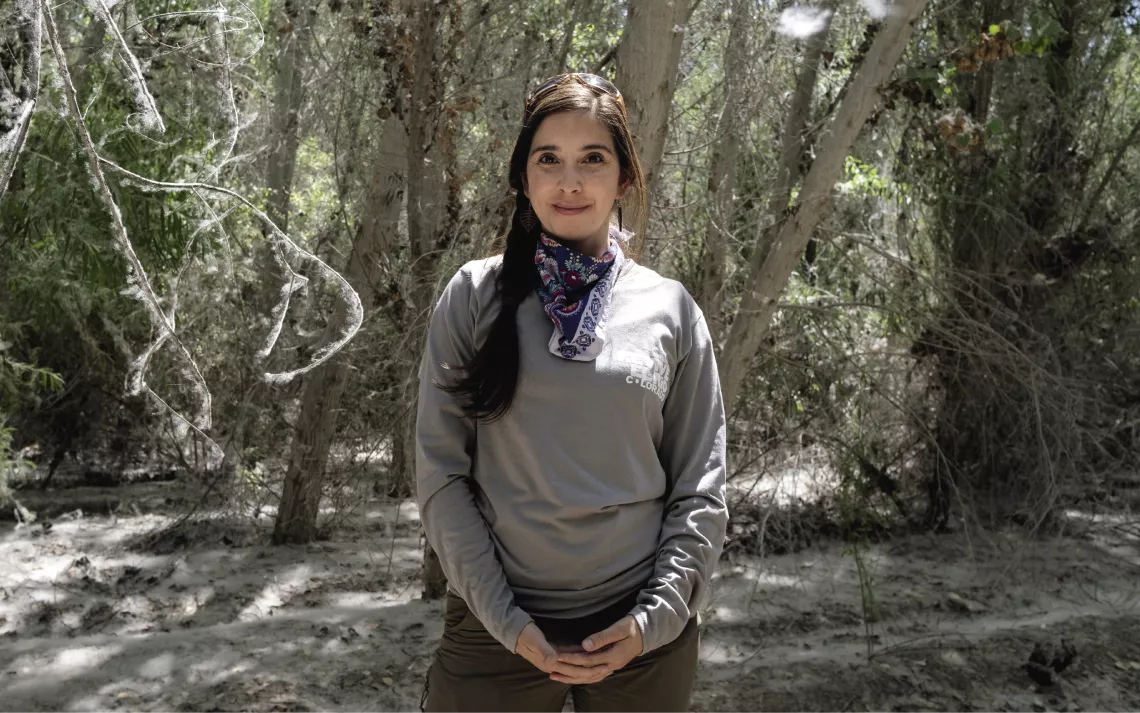
Gabriela González began working on the delta restoration in 2015.
Although the pulse flow helped revive parts of the delta's estuary ecosystems, it was ultimately not the most efficient restoration tool. Because the upper reaches of the delta located just south of the international border have a low water table, the sandy ground absorbed much of the water before it could reach the restoration sites farther downriver. Scientists realized that they could get the water to do more restoration work by delivering it in smaller, more targeted doses, closer to the places where the vegetation could take advantage of it. The most recent water releases now bypass the Morelos Dam and the driest stretches of the delta, traveling instead through irrigation canals before reconnecting with the river 40 miles downstream.
Altogether, the rewilding scheme has mostly gone according to plan. In the four years after the first pulse flow, bird abundance increased by 80 percent and bird diversity increased by 27 percent in restored areas.
AFTER González and Restrepo showed me around the forest, we set out by kayak into Laguna Grande, paddling along a narrow channel through thick reeds and then out to the main stem of the Colorado River. A breeze rippled across the surface of the river, cutting the intensity of the sun and the heat. Restrepo wanted to show us a beaver dam. Like birds, beavers are indicator species—"ecological excavators," Restrepo called them. Their dams divert creeks and raise water levels, which brings more fish, more insects, and predators like coyotes and bobcats.
He consulted his GPS to figure out how far we were from the beaver dam. Half a kilometer, he said, putting a piece of pink tape around a tree poking up in the middle of the river to mark our return. We started paddling upstream, the silence broken only by the birdsong and bullfrog croaks.
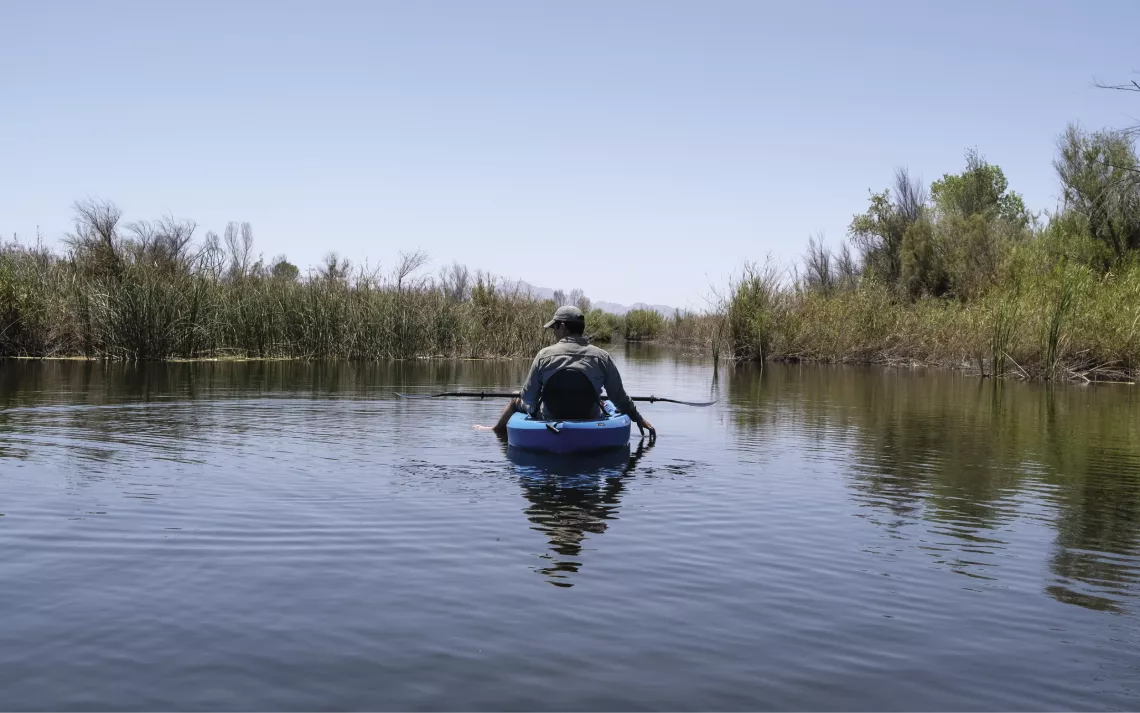
A hydrology specialist with the Sonoran Institute paddles in Laguna Grande.
Eventually a wall of reeds—a type called carrizo—blocked our way. Behind it, we heard what sounded like a small waterfall: the beaver dam. From the sound, Restrepo guessed that it was a big dam—proof, he thought, that there must be several colonies here. Later, Restrepo showed footage from his camera traps, revealing that other species have returned too: coyotes, bobcats, skunks, and various bat species. "Even with less than 1 percent of the river's flow, all these species have come back," he said.
GROWING UP IN ENSENADA, on the Pacific coast of Baja California, González spent much of her time outside. To her mother, she was "Monkey," owing to her habit of climbing a rope that hung from a large tree in their backyard. A neighbor, so terrified by a six-year-old in pink sweatpants high in the trees, would knock on their door to warn González's mother, who remained unfazed.
González first visited the delta in 2006—before the restoration efforts started—as a biology undergrad at the Autonomous University of Baja California doing bat surveys. It was summertime and temperatures in the delta were unbearably hot. A sign indicated she was near a place called the Río Colorado, which she thought was funny: There was not a drop of water around, let alone a river.
In 2015, González talked herself into a job as the Sonoran Institute's new environmental education coordinator. Her role presented unique challenges. Mexicali, unlike most Mexican cities and towns, has no tree-lined zocalo—the traditional central plaza—and few parks or green spaces. In the summer, temperatures routinely reach over 110°F, and Mexicali is plagued by air pollution, due to the hundreds of maquiladoras that surround the city. It is not a place where children play outside.
"When people come down this little dirt path, I know it sounds silly, but it's like a magical door for them," said González (who would leave her longtime post at the Sonoran Institute in July to begin a master's program in ecological restoration and climate change). Visitors to the lagoon hear sounds they've never heard before—birds chirping, water rushing over a beaver dam. They see animals they never knew existed in their own backyard. "Some kids cry," she added. "This is so wild for them."
González imagined that visiting a place like Laguna Grande could be the catalyst that people in the Mexicali Valley needed to nurture a connection with the natural world—the kind she'd experienced as a child. She organized school tours, community walks on weekends, and spring planting days, some of which attracted as many as 200 volunteers. Occasionally, she hired a taco catering company. "It's like a big party," she said.
When older people come to Laguna Grande, their reaction is very different from younger visitors'. For many of them, it's a nostalgic place. "Many haven't seen the river in more than 50 years," González said. "And they come here—they have an instant flashback. Like, 'Oh, my grandpa used to take me to the river. We used to fish and swim, and then there was no water left.'"
Many of the scientists who participated in the delta's restoration efforts likely didn't pay much attention to the social impacts of their work. A few weeks after the 2014 pulse flow, when there was water in the river, Karl Flessa, a geosciences professor at the University of Arizona and the chief scientist for one of the Colorado River Delta monitoring teams, saw a man help an elderly woman down to the river, just south of the border. It struck Flessa that despite all the fancy systems monitoring everything from birds to groundwater levels, there was no way to measure the value of such moments in all their tenderness and joy.
"I'm a card-carrying biophysical scientist," Flessa told me. "But one of the things that caught us scientists completely flat-footed was the community response to the water as it flowed under the bridge at San Luis—the whole town came out. It was a big fiesta."
After seeing that response, he said, he began to focus on making sure that restoration activities take into account the communities they're embedded in. "I want to make sure restoration isn't just about birds and trees," he said. "It's got to be about people too."
MUCH OF THE WORK behind the delta's restoration takes place in a dusty ejido (a small rural community) called Francisco Murguía. One day, I drove with González down the main drag and onto a dirt road through a neighborhood of modest single-story homes until we arrived at the Sonoran Institute's tree nursery, located in the backyard of an employee's house. At the nursery, two women were transplanting a wheelbarrow filled with globe mallow seedlings. Behind them, rows of baby cottonwood, mesquite, and willow saplings sat under a canvas tent waiting to be planted—soon to be among the more than 200,000 trees that the Sonoran Institute has replanted in the delta.
One of the women was Celia Alvarado Camacho. When Alvarado Camacho started working at the nursery 12 years ago, she didn't know she lived near a river, believing it had disappeared decades ago. She had grown up in the central Mexican state of San Luis Potosí, where forests blanketed the mountains. In the Mexicali Valley, she missed the shade of the trees and the connection to nature she once had. Through her work at the Sonoran Institute, Alvarado Camacho felt like she was reclaiming a part of herself she thought she had lost. Her son now works as a park ranger at Laguna Grande, and she is proud that together they are helping create an environmental solution. This year alone, the organization will plant around 12,000 trees.
From the nursery, we headed south through the Mexicali Valley toward the estuary. Fields of crops flashed by until they gave way to sand. A few fishing villages at the northern edge of the mud flats marked the beginning of the estuary. We drove across what looked like a dried-up lakebed, its cracked mud encrusted with salt and interspersed with pools of brackish water.
But here and there, ribbons of green emerged along the banks of the river channels. As part of the restoration efforts, the Sonoran Institute has replanted salt grasses, which are slowly gaining ground, nourished by the freshwater that has begun to flow into the estuary again. Local fishermen have reported better catches. One day, González hopes, locals will be able to swim and picnic at the edge of the river.
Upstream, however, the condition of the Colorado looked more dire than ever. A month and a half after I left the delta, the federal government told the Colorado River Basin states that they needed to reduce their water consumption from the river by an astounding 2 to 4 million acre-feet to stave off a crisis. Otherwise, the Feds would intervene and impose the cuts for them. Water levels in both of the river's major reservoirs, Lake Mead and Lake Powell, were falling to record lows, but the deadline for the states to come up with a plan passed in August, and the government never followed through on its threat, leaving many wondering what will keep the river from collapsing.
I asked González what might happen if the Colorado River becomes so meager that neither the United States nor Mexico would agree to continue assigning water for the delta. "I can't think about that," she said. In the meantime, a big part of the restoration effort's goal is to make the ecosystem resilient enough to withstand the next catastrophe.
Soon we were in a narrow metal boat, motoring down the last stretch of runnable river before the sea. We skimmed across water the color of pea soup—the result of algae born from agricultural runoff. Salt cedars lined the riverbanks, their branches grasping for the sky like thousands of skeletal hands. A blue heron drifted above them, its wings flapping slowly, looking for something we could not see.
This article appeared in the Fall 2022 quarterly edition with the headline "Oasis in the Desert."
 The Magazine of The Sierra Club
The Magazine of The Sierra Club
